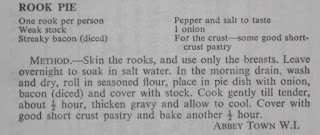Although I was brought up in Cumbria, I wasn't brought up with rum butter. When I was about 11, a school friend gave me some for Christmas, and I ate it with digestive biscuits (which were thus much improved). Last time I hosted Christmas, I made rum butter instead of brandy sauce to go with the Christmas pudding, and that's now my tradition.
This year I added rum nickies to the tradition. The coin toss had dictated that my dad made mince pies and Christmas cake, and I made the pudding - but this meant no mince pies before the visitors arrived, and as our rule is no mince pies after Christmas morning (and there were rather fewer mince pies at work this year than when I worked in London!), it meant almost no mince pies. But rum nickies aren't mince pies so we could have them before and after.
Rum nickies have come to a certain amount of attention in recent years - not exactly sticky toffee pudding, but plenty of links to recipes and products, including rum-nicky-in-a-jar. I've now got five small books of Cumbrian/Lakeland recipes (two modern ones available in all good tourist bookshops, and three local publications from the 1960s-70s).
All but one include recipes for rum nickies, and all of them concur that:
- rum nickies are individual pastries, like mince pies
- the filling is currants (and only currants) soaked in rum and spices
- rum nickies are large shared pies, commonly with a lattice topping (rather than a sheet of pastry with nicks in)
- the filling is primarily dates, with candied stem ginger and sometimes currants, sultanas or even dried apricots, soaked in rum, and surprisingly, an absence of spices
One of the cookbooks is a 1960s WI cookbook from my Grandma's shelf. It doesn't show the date, but it's pre-decimalisation, pre-metrification and pre-Cumbria. Many of the recipes indicate which WI contributed them - Linstock, Dacre, Scotby, Moor Row, Newton Arlosh... We particularly enjoyed some of the Gamblesby contributions, which included two separate recipes for burnet wine - we imagined two ladies competing to get their recipe included. We're still not sure what these very plentiful burnets are, we're fascinated by the function of the piece of toast, and we prefer the recipe that ends "A little rum greatly improves the wine". The more of the book you read, the more you suspect that a little rum would greatly improve many things.
| Gamblesby Burnet wine 1
|
Gamblesby Burnet wine 2 |
| Fowl or foul? | Rook or yuck? |
- Gamblesby (in Glassonby) or Gamelsby (by Aikton) is one of my favourite village names as it's so little altered from the Norse. I'm tempted to buy the Ikea Gamleby shelf purely for its name. When I went to Copenhagen some years ago, flying to an airport in the budget airport definition of 'near' and catching a train to the city, the similarity of the placenames meant I could have been on the Settle-Carlisle line. Although with newer carriages and more passengers. And our views are better.
And then I read: ...Cumberland gave us rum butter to have with our Christmas pudding, and also from Cumberland came "standing pie" or "sweet pie", filled with chopped mutton, apples and raisins, the grandfather of the mince pie. Back to the historic cookbooks to find a recipe - meat and fruit together are quite fashionable at present and this one has to be tried. Although the recipes are clear that this is a large plate pie (i.e. pastry lid but not base), that wouldn't meet my need for an outdoor pasty, so individual handheld pasties were the way to go. I used the WI recipe with a cross-reference to Jane Grigson. I haven't made handheld pasties for years, and I overfilled them as usual (but I take heart from the note about avoiding headriggs from another recipe) and a couple exploded.
The recipe includes really quite a small quantity of meat to fruit, so I made double quantities, enough for nine handheld pasties, one large pie to serve 6-8 and one smaller pie for 2-4. Next time I make it I'll use more meat to fruit (tastes have changed) and include better meat and more fat (supermarket meat too lean and this needs something more to bind it and carry the flavour of the meat). And think about whether there's anything else that could bind the filling a bit more.
For example, could you use rice in a pie filling? I used a Diana Henry recipe for lamb pilaf to use up some of my roast goose glut, and then realised it was already quite close to being a recipe for Cumberland pilaf - just adjust the fruits and add rum!








No comments:
Post a Comment